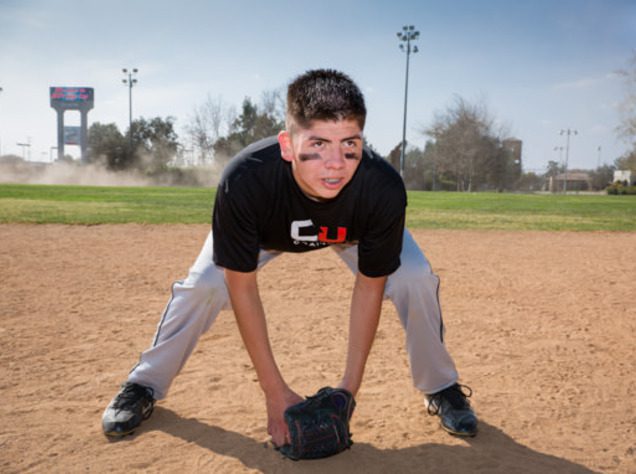No matter where you play, the importance of being able to cleanly field a ground ball is paramount, even for outfielders! Professionals make fielding grounders look routine and simple, but anybody who has played the game knows that they can be unpredictable, nerve-wracking, and full of pressure. The ability to make these plays effectively requires skill and concentration, so take a look at CoachUp’s videos and tips to help you out the next time a scorcher comes your way.
There are four fundamentals that go into fielding a ground ball as effectively as possible, they are: body positioning, hand positioning, body movement, and timing. Just using one of these skills won’t get the job done, and, in fact, they must all be used in perfect symphony to not only quickly field the ball, but also have time to throw the runner out as well. The best way to learn is to experience — take grounders before the game and after practice. Every grounder is a unique situation, so being prepared as much as possible will only help you in the long run.

Body Positioning
The first thing to understand about fielding a ground ball is the importance of body positioning. Place your feet about shoulder width apart, bending at the knees and waist. This athletic stance will allow you to keep the ball out in front of your body so you can watch it all the way into your glove.
You wouldn’t want to shoot a soccer ball while jumping, or try to dunk a basketball blindfolded, and the same applies here — the best form will make a world of difference. Put yourself in a literal position to succeed. Additionally, the more of your body you get behind the ball, the better. That way, if there’s a cruel bounce or misfield, you’ll still have the possibility of knocking the ball down with the rest of your body. That, at the very least, will keep the ball in the infield, but you could still have a chance at first depending on how quickly you recover. The key here is making yourself as big as possible!
Hand Positioning
Now, position your hands. Keep your glove wide open and facing upward. When the ball comes your way, keep your glove on the ground in order to scoop the ball smoothly. If the ball looks like it is going to bounce, start with the web of your glove touching the ground, and then raise it to the ball as it comes to you. Try to have soft hands, which means not stabbing at the ball or overreaching for it. Catch it like you might try to catch an egg, taking away all of its momentum as you see it into your glove.
You should keep your glove in front of you as the ball approaches, and then bring it into your body with the catch. It’s also easier to field a grounder using two hands. Keep your non-glove hand above your glove so you can trap the ball as it reaches your glove. Even though it might seem silly or childish, the saying every young ballplayer learns rings true no matter your age: the alligator is always hungry! Use your glove and hand in symphony as an imaginary reptile and swallow that ball up whole!
When you trap the ball, bring both hands up to your chest. This will help you regain your balance and give you greater mobility before throwing the ball. One drill that helps with hand positioning and timing the hop of a grounder is to practice fielding a series of ground balls from your knees. This will force you to stay on the ball and adjust to fielding short hops and in between hops. Additionally, you will not be able to bail on any tough short or in-between hops. Keeping your head down on the ball in this position and learning to be quick with your hands will put you in a good place to field smoothly when you involve your feet later.
Body Movement
When the ball is hit, read its trajectory and move towards it. You don’t have to charge the ball, but you should begin moving towards it while getting into your position. It’s important to remain in control with your eyes on the ball so that it doesn’t get by you. Basically, you want to be as aggressive as possible, all while ensuring that the ball stays in front of you. Keep your steps short so that you can make adjustments in a moment’s notice.
Timing
The hardest part of fielding a ground ball is, believe it or not, the timing. You need to know when to run towards the ball or when to back away to allow the ball to bounce higher, which requires loads of diligent, consistent practice. You’ll constantly have to choose whether to catch it off of that bounce, or this bounce, whether to dive, slide, or jump — like we said before, every grounder is a unique opportunity!
A good drill to practice your timing requires two people standing about forty feet apart. The players should take turns throwing each other grounders and fielding them. When throwing the ball to the other player, mix up where the ball bounces before it reaches the other player. The closer the ball is to the fielder when the ball bounces, the harder it will be to catch. This will force the fielder to choose between trying to field the ball immediately and taking a step back to allow the ball to bounce higher before catching it.
(Related: Read about the angles of bunting here.)
Huddle Up
There is no replacement for fielding as many ground balls off of a bat as possible, but incorporating these baseball drills into your training should help you increase your learning curve as an infielder.
However, if you’re still struggling to be effective in the infield, consider booking one of CoachUp’s private trainers to help you out. They’ll have you confidently and consistently ready for whatever is hit your way — what are you waiting for?
Be prepared for the biggest moments by mastering the small ones off the field.
How useful was this post?
Click on a star to rate it!
Average rating 0 / 5. Vote count: 0
No votes so far! Be the first to rate this post.



